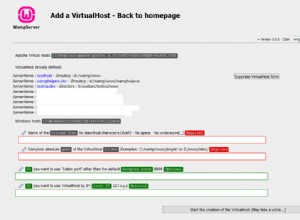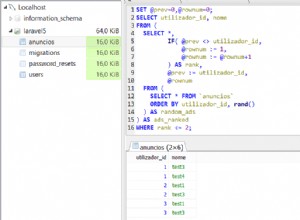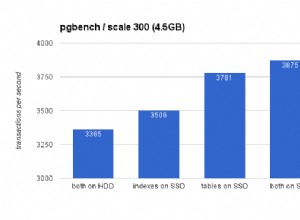आप समस्या विवरण में थोड़े अराजक प्रतीत होते हैं, कृपया अपने प्रश्न को प्रारूपित करें और इसे और अधिक पठनीय बनाएं। वैसे भी उपाय सरल हैं। आपको केवल एक if . की आवश्यकता है कथन, जहां, स्तर के आधार पर, आप पहली या दूसरी तालिका और उचित कॉलम में खोजते हैं:
create or replace function get_accountdetails (par_input in varchar2) return varchar2 is
v_aid varchar2(10);
v_db varchar2(10);
v_lvl varchar2(10);
v_ret varchar2(20) := '';
begin
v_aid := regexp_substr(par_input, '\d+', 1, 1);
v_db := regexp_substr(par_input, '\d+', 1, 2);
v_lvl := regexp_substr(par_input, '\d+', 1, 3);
if v_lvl = 1 then
select dim_cust_key
into v_ret
from dim_cust_acnt
where level1_account_id = v_aid and database_id = v_db;
elsif v_lvl = 2 then
select dim_cust_key
into v_ret
from dim_cust_dept
where level2_account_id = v_aid and database_id = v_db;
else
select dim_cust_key
into v_ret
from dim_cust_dept
where level3_account_id = v_aid and database_id = v_db;
end if;
return v_ret;
end;
यहां टेबल और सैंपल फंक्शन कॉल हैं:
create table dim_cust_acnt (dim_cust_key, level1_account_id, database_id) as (
select 1123, 112, 22 from dual union all
select 1234, 113, 23 from dual );
create table dim_cust_dept (dim_cust_key, level2_account_id, level3_account_id, database_id) as (
select 1587, 245, 301, 21 from dual union all
select 1576, 289, 304, 20 from dual);
select get_accountdetails('[112].[22].[1]') from dual; -- result: 1123
select get_accountdetails('[289].[20].[2]') from dual; -- result: 1576
select get_accountdetails('[301].[21].[3]') from dual; -- result: 1587
कृपया उचित कॉलम नामों का उपयोग करें जो आपके वास्तविक डेटा में हैं, और यदि आवश्यक हो तो चर प्रकार और लंबाई समायोजित करें। मुझे लगता है कि आप एक सम्मिलित क्वेरी का भी उपयोग कर सकते हैं, किसी विशेष फ़ंक्शन की आवश्यकता नहीं है, नीचे जैसा कुछ है। मैंने full join . का उपयोग किया , क्योंकि आपके उदाहरणों में मेल खाने वाली पंक्तियाँ नहीं हैं। शायद आसान join पर्याप्त होगा।
with t(par_input) as (select '[112].[22].[1]' from dual)
select dim_cust_key
from dim_cust_acnt a
full join dim_cust_dept d using (dim_cust_key)
cross join t
where ( 1 = regexp_substr(par_input, '\d+', 1, 3)
and regexp_substr(par_input, '\d+', 1, 1) = level1_account_id
and regexp_substr(par_input, '\d+', 1, 2) = a.database_id )
or ( 2 = regexp_substr(par_input, '\d+', 1, 3)
and regexp_substr(par_input, '\d+', 1, 1) = level2_account_id
and regexp_substr(par_input, '\d+', 1, 2) = d.database_id )
or ( 3 = regexp_substr(par_input, '\d+', 1, 3)
and regexp_substr(par_input, '\d+', 1, 1) = level3_account_id
and regexp_substr(par_input, '\d+', 1, 2) = d.database_id )
परिणाम:
DIM_CUST_KEY
------------
1123
अगर आप with हटाते हैं और cross join भागों और intoजोड़ें खंड तो आप if . के बजाय फ़ंक्शन में इस क्वेरी का उपयोग कर सकते हैं बयान।
संपादित करें:
देरी के लिए खेद है, मैंने हाल ही में स्टैक ओवरफ़्लो को नहीं देखा। यहां दो उदाहरण दिए गए हैं कि आप अपने कार्यों को कैसे लिख सकते हैं:
यह फ़ंक्शन संयोजित स्ट्रिंग लौटाता है:
सूची के रूप मेंselect get_details_1('[112].[22].[1],[289].[20].[2],[301].[21].[3]') as list from dual;
LIST
------------------
1123,1576,1587
और दूसरा फ़ंक्शन पाइपलाइन किया जाता है और डेटा को स्ट्रिंग्स के पूर्वनिर्धारित संग्रह के रूप में लौटाता है, इसलिए मान अलग-अलग पंक्तियों में होते हैं।
select column_value
from table(get_details_2('[112].[22].[1],[289].[20].[2],[301].[21].[3]'));
COLUMN_VALUE
------------
1123
1576
1587
आप पहले सभी इनपुट डेटा को पार्स कर सकते हैं, उन्हें कुछ संग्रह में संग्रहीत कर सकते हैं और फिर एक क्वेरी में बल्क कलेक्ट का उपयोग कर सकते हैं। कई समाधान और संभावनाएं हैं, व्यक्तिगत रूप से मैं पाइपलाइन फ़ंक्शन का उपयोग करूंगा, लेकिन यह इस बात पर निर्भर करता है कि आपको किस प्रकार के आउटपुट की आवश्यकता है (संग्रह या समेकित स्ट्रिंग)। इसके अलावा आप begin ... end जोड़ सकते हैं ब्लॉक और हैंडल अपवाद when no_data_found . आप तब विशेष जानकारी प्रस्तुत कर सकते हैं या निष्पादन को तोड़ सकते हैं, यह इस बात पर निर्भर करता है कि ऐसी स्थिति में किस व्यवहार की अपेक्षा की जाती है।
समारोह 1:
create or replace function get_details_1 (par_input in varchar2) return varchar2 is
v_aid varchar2(10);
v_db varchar2(10);
v_lvl varchar2(10);
v_ret varchar2(20);
v_all varchar2(200) := '';
i_cnt int := 0;
begin
loop
v_aid := regexp_substr(par_input, '\d+', 1, i_cnt + 1);
v_db := regexp_substr(par_input, '\d+', 1, i_cnt + 2);
v_lvl := regexp_substr(par_input, '\d+', 1, i_cnt + 3);
i_cnt := i_cnt + 3;
exit when v_aid is null;
select dim_cust_key
into v_ret
from dim_cust_acnt a
full join dim_cust_dept d using (dim_cust_key)
where (v_lvl = 1 and level1_account_id = v_aid and a.database_id = v_db)
or (v_lvl = 2 and level2_account_id = v_aid and d.database_id = v_db)
or (v_lvl = 3 and level3_account_id = v_aid and d.database_id = v_db);
v_all := v_all||','||v_ret;
end loop;
return ltrim(v_all, ',');
end;
फंक्शन 2:
create or replace function get_details_2 (par_input in varchar2)
return sys.odcinumberlist pipelined is
v_aid varchar2(10);
v_db varchar2(10);
v_lvl varchar2(10);
v_ret varchar2(20);
i_cnt int := 0;
begin
loop
v_aid := regexp_substr(par_input, '\d+', 1, i_cnt + 1);
v_db := regexp_substr(par_input, '\d+', 1, i_cnt + 2);
v_lvl := regexp_substr(par_input, '\d+', 1, i_cnt + 3);
i_cnt := i_cnt + 3;
exit when v_aid is null;
select dim_cust_key
into v_ret
from dim_cust_acnt a
full join dim_cust_dept d using (dim_cust_key)
where (v_lvl = 1 and level1_account_id = v_aid and a.database_id = v_db)
or (v_lvl = 2 and level2_account_id = v_aid and d.database_id = v_db)
or (v_lvl = 3 and level3_account_id = v_aid and d.database_id = v_db);
pipe row (v_ret);
end loop;
return;
end;




